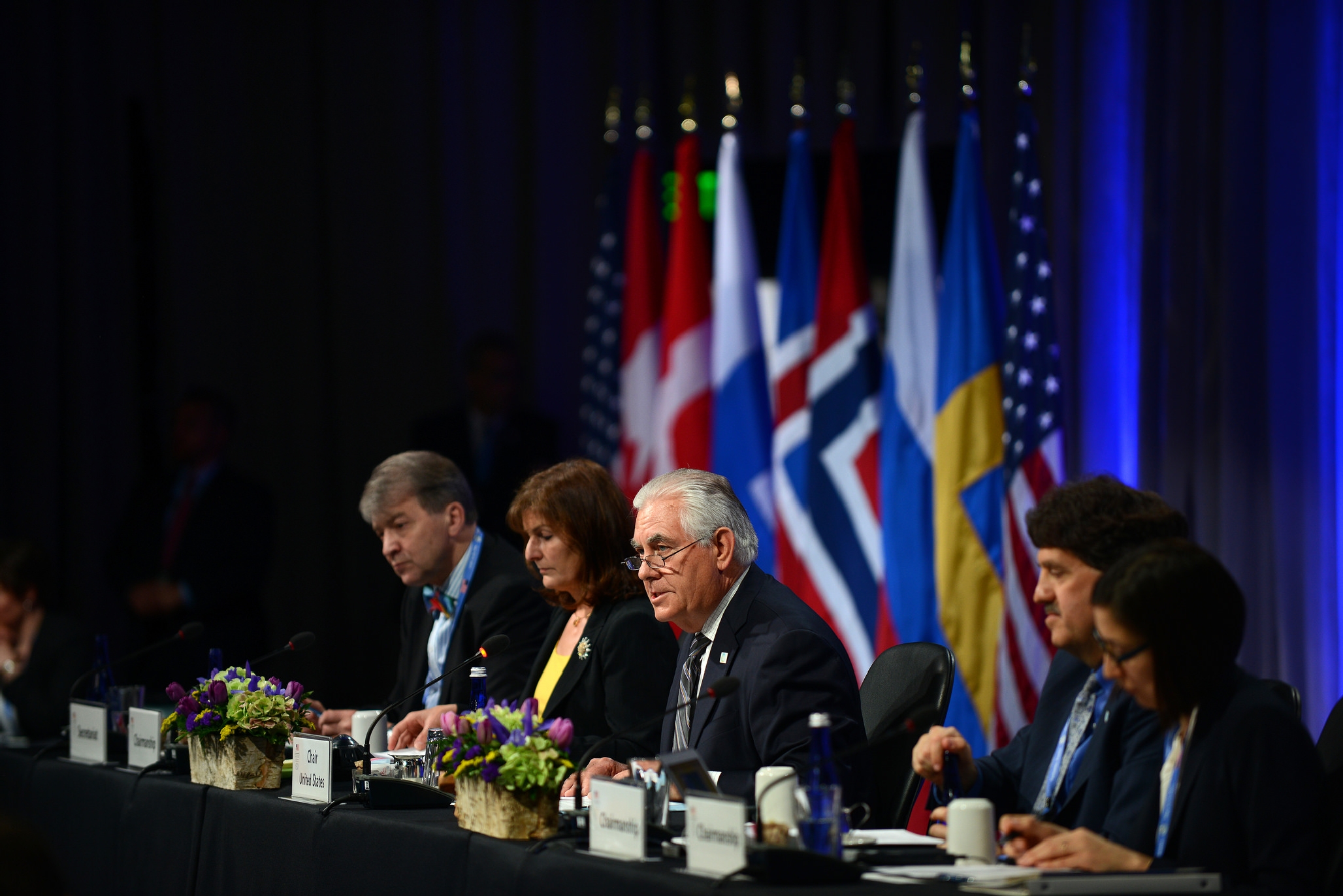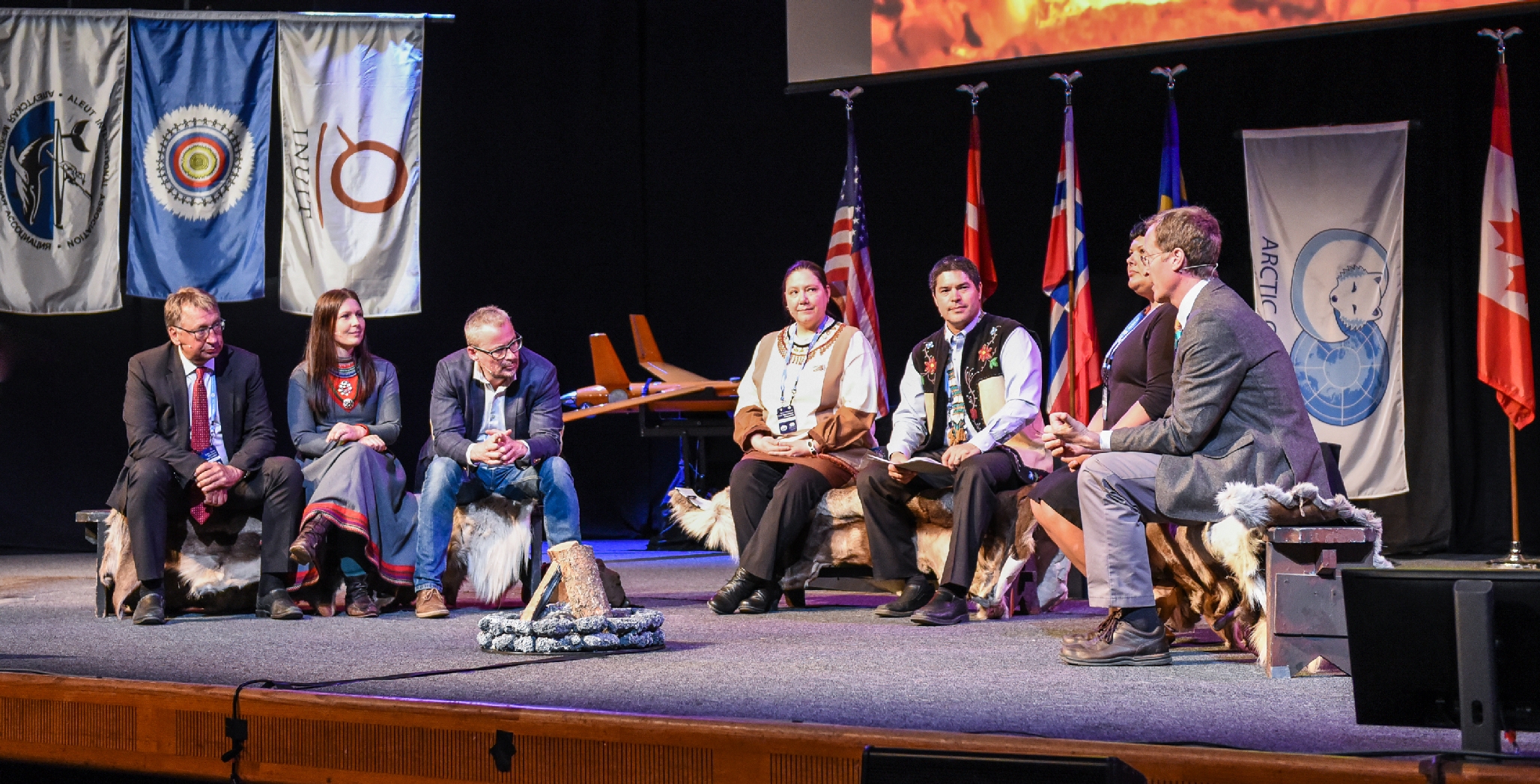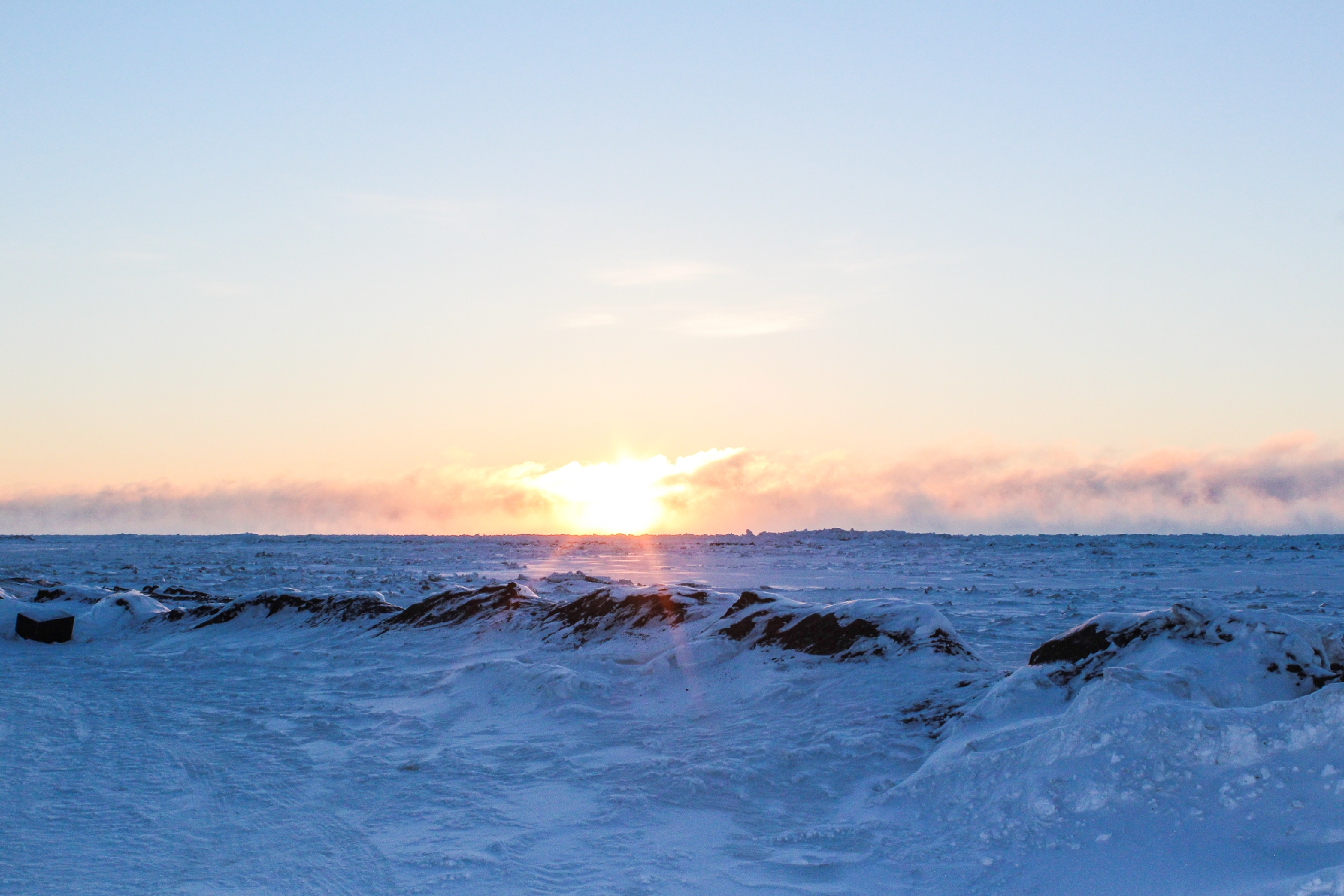Summer 2017
The Challenge of Arctic Governance
– Douglas C. Nord
Governance is challenging in any context, but it becomes even more complex when attempted in an area that, until recently, has had little experience with regional decision-making.
In June 2013, delegates from across the circumpolar world were gathering in Kiruna, Sweden for the Eighth Ministerial Meeting of the Arctic Council. The cool and foggy weather was not the most auspicious and many worried that the meeting would have to be delayed if the foreign ministers’ planes could not land. Inside the conference venue, the atmospheric conditions were no more promising. After two years of concerted effort, it looked like the Swedish initiative to expand the number of international observers to the organization would be blocked by the continued opposition of Canada and Russia. It would require a late-night negotiating session brokered by then- U.S. Secretary of State John Kerry to overcome this reluctance and for non-Arctic states, including China, India, and Japan, to become Observer members.
Four years later, the Arctic Council’s forward momentum was threatened by another impasse: the Trump administration’s refusal to assent to a proposed declaration identifying climate change as a major regional threat. Upon arriving in Fairbanks, Alaska U.S. Secretary of State Rex Tillerson made it clear that Washington had significant reservations regarding the content of this document. Without a green light from the U.S., the declaration would be dead in the Arctic water, so to speak, as the Council works by consensus. For a few critical hours, it looked like one of the major initiatives of Washington’s own 2015-17 Chairmanship of the Arctic Council was to be abandoned. In the end, Tillerson’s counterparts were persuasive enough to win U.S. support for the non-binding declaration.

Both of these diplomatic vignettes illustrate the continuing challenge of establishing a stable and effective governance structure for the Arctic. The Arctic Council, the main intergovernmental forum on the region, has been synonymous with that effort for the past two decades. Established by the eight Arctic states – Canada, Denmark (on behalf of itself, the Faeroe Islands, and Greenland) Finland, Iceland, Norway, Russia, Sweden, and the United States – it has endeavored to highlight the needs of this northernmost region and facilitate collective action. Its six working groups study and report on a broad range of issues, from climate change to emergency preparedness. The Council’s efforts have not always been quick or straightforward, but it has made steady progress, nonetheless. As the Arctic has moved from the margins of international affairs to become a focus of global concern, the question of what regional governance should look like has become increasingly loaded. As the Arctic Council continues to try to answer that question, the stakes will only grow.
Five Ws and An H
Not unexpectedly, there has been less than complete agreement among policymakers, experts, and others with interests in the region, both in terms of how they view the structures currently in place and their prescriptions for future action. Divisions of opinion radiate from six central, intertwined questions: Who is to govern? What is to be governed? Where is governance to take place? When is governance to operate? How is governance to function? And, finally, why is regional governance necessary?
The Arctic Council, in its original formulation, provided a clear answer to the first of the 5 Ws; the countries of the circumpolar north are its chief constituents. Although these “Arctic Eight” claim predominance, the Council also accords representation to several indigenous peoples of the North. These Permanent Participants are given seats at the negotiating table, consulted in most decision-making processes, and involved in the ongoing research efforts of the Council’s working groups. The Arctic Council also grants Observer status to several non-Arctic states, international organizations, and other non-state actors, and has moved to expand the list over the past decade.

As such, the “who” question has become more complex: In trying to balance the desires of the Arctic Eight with the views and opinions of its non-state members, the Council has sought to counter criticism by some that it is elitist and hierarchical in its operation. The Council has also been faced with reconciling the need to protect its distinctive “northern voice” and orientation with the reality that global actors far from the Arctic Circle are increasingly interested in participating in its deliberations and research. In Kiruna in 2013, China, India, Italy, Japan, Korea, and Singapore became Observers, bringing the total approved non-Arctic states to 13.
The question of what should be governed in the Arctic has been a central topic of discussion and will remain as such into the future. Since the establishment of the Arctic Council in 1996, the “twin pillars” of environmental protection and sustainable development have supposedly underpinned its work. In its early days, the Council clung rather tightly to pillar one, addressing issues such as transboundary pollution, environmental degradation, and later, climate change in the Arctic. More recently, its agenda has expanded to include health, education, and support for indigenous languages and cultures – more in keeping with the second pillar. A debate now exists between those who favor continuing a focus on the first pillar and those who prefer a new emphasis on the human presence in the Arctic, as embodied by the second pillar. The two, of course, are not unrelated, but the balance that the Council strikes between these poles of interest will be a benchmark for its ability to foster cooperation among members and for its capacity to shape its own purview of action.
The prospect of mutual benefit through common enterprise has the potential to build trust between long-standing rivals, like the United States and Russia, but this remains an ongoing and often elusive exercise.
Going it Together, Going it Alone
An additional, overarching “what” challenge for the Council has been to promote collective action as an alternative to unilateral moves by sovereign states. Some larger members, including Russia, the United States, and Canada, have been reluctant to relinquish their prerogative to address issues from their national perspectives – particularly regarding claims to resources, security, and economic development in Arctic lands and waters. The prospect of mutual benefit through common enterprise has the potential to build trust between long-standing rivals, like the United States and Russia, but this remains an ongoing and often elusive exercise.
“What” issues are intimately tied to “where” issues, also tapping into the tension between collective work and sovereign right. The Arctic Council’s early initiatives were land-based, such as its scientific work on environmental degradation. Surveys of plant and animal populations across various circumpolar landscapes soon followed. Significant inquiries into the health, education, and employment needs of the peoples of the Arctic have been initiated only recently. This hesitancy to move into areas of human interest reflects the reluctance of the Council to infringe upon the right of governments to design and deliver social services within their respective borders. As mentioned, the Council will need to strike a balance, but amid rising human activity in the Arctic and the concerns that come with it, it is likely that human-centered research will be expanded.

The maritime interests of the Arctic Council came a bit later. Its first efforts included studies of transboundary maritime pollution and coastline degradation as well as surveys of threatened maritime species and stocks. But again, issues of national sovereignty impeded further work. The 1982 UN Convention on the Law of the Sea established maritime territorial boundaries and exclusive economic zones, but disputes continue – such as on the boundary between the United States and Canada in the resource-rich Beaufort Sea and on control of the Lomonosov Ridge, which cuts through the Arctic Ocean. That means Council studies related to Arctic Ocean fisheries and offshore mineral and energy resources were off the table. These remain “sensitive” issues within the Council.
The Arctic Council’s response to the question of when region-wide governance should apply has been clear and consistent from the start: it should operate only as a supplement to the efforts of the individual Arctic states and only upon their request. From this perspective, any form of collective Arctic management should apply only when problems transcend borders or cannot be dealt with effectively on a unilateral basis. Recent initiatives by the Arctic Council on search and rescue and preparedness for pollution emergencies fit within this framework. So too does sharing specialized knowledge or technology to address certain pollution hazards.
Some external advocates may wish it were otherwise, but lack of sufficient political will and financial commitment means that the Council is unable to operate more widely at this time.
However, as we’ve seen, it’s often open to interpretation whether a country is better served to work with partners or go it alone. Today, it is a fact that Arctic governance will not be the first response to any identified environmental, social, or economic problem within northern communities. These issues remain largely the responsibility and prerogative of individual governments and, to a certain extent, the indigenous Permanent Participants. Some external advocates may wish it were otherwise, but lack of sufficient political will and financial commitment means that the Council is unable to operate more widely at this time.
The Arctic Council’s answer to how it can govern stems precisely from recognition of this fact. At present, there appears to be little interest in creating a broad array of regional agreements and regulations that might guide the conduct of the Arctic states or residents. Additionally, as an intergovernmental forum rather than an empowered international organization, the Arctic Council lacks the full capacity to enact any resulting measures. As far as funding is concerned, it is already a challenge to secure financial contributions from individual states for agreed-upon Council initiatives.
Given these circumstances, the Council has generally remained within the more limited scope of seeking to promote greater local and global awareness of northern concerns. These include the rapid rise in Arctic temperatures, the melting of polar seas, and the challenges of developing natural resources in fragile ecosystems. In some instances, other venues and frameworks – such as the UN Environment Programme, the Polar Code, and the Law of the Sea – are deemed more appropriate for addressing Arctic concerns. In other cases, the Arctic Council has been able to sponsor international agreements that address more limited, regional concerns, such as conventions on Arctic search and rescue and oil pollution preparedness and response.

Why? It’s the most existential question for many governance bodies. The limits of its capacity to act notwithstanding, the Arctic Council has offered multiple answers. At times, it has cited the conditions faced by the lands and peoples of the region and the need to share information, insights, and best practices. At other times, it has pointed to the dramatic changes on the Arctic horizon, brought about by climate change, globalization, and “the race for resources”. The need to integrate a distinctly Arctic perspective into broader global discussions and negotiations has also been claimed as a raison d'être.
In fact, despite continuing disagreement between certain Arctic governments and inhabitants on the direction and pace of governance, there is a surprising level of agreement on the basic need for such a project.
In each instance, the Arctic Council has emphasized the importance of cooperative efforts among Arctic neighbors to advance common causes. In fact, despite continuing disagreement between certain Arctic governments and inhabitants on the direction and pace of governance, there is a surprising level of agreement on the basic need for such a project. Proponents say a system of Arctic governance is required to address five fundamentals – the need to protect the environment; develop resources sustainably; ensure that Arctic inhabitants benefit from that development; broaden participation in Arctic decision-making processes; and promote cooperation instead of conflict in the region.
Next on the Agenda
Beyond the who, what, where, when, why, and how, there is the question of what’s next. The Trump administration has provided new challenges and uncertainties for advancing collective action in the Arctic. The president’s general skepticism of multilateral initiatives, along with his withdrawal of the United States from the Paris climate accord, suggests that there may be little support from Washington for cooperative environmental protection efforts at the top of the globe. Trump’s decision to pick the former head of ExxonMobil as secretary of state indicates that higher priority may be given to new oil and gas exploration in the region. The administration has already signaled its desire to withdraw Obama-era restrictions on drilling in the Bering Sea and the Arctic National Wildlife Refuge in Alaska.

The U.S. president’s continuing “Russian problem” may even impede new efforts by the Arctic Council to highlight the region as an area of global concern. Finland, the current Council chair, has worked diligently behind the scenes for a number of years to convene a summit during its leadership term between the heads of Arctic governments. It secured Russia’s participation last fall. However, Helsinki has since backed away from the initiative due to concern that the United States might decline to take part, or that a meeting involving Putin and Trump at this point might divert attention from the summit’s intended purpose.
Even without setting geopolitics aside, the Arctic Council can continue to do valuable work if it focuses on the fundamentals that its proponents cite. Dedication to environmental protection will, and must be, a fundamental aim of the body’s cooperative efforts. The Council has suggested ways in which the Arctic powers and the broader global community can act as responsible stewards of resources, and as development gains pace, this vision must keep pace. There was agreement from the Council’s outset that the indigenous peoples of the Arctic should have a significant claim to any benefits derived from development of their traditional lands and that they should have their interests, needs, and aspirations addressed on a priority basis. This requirement should continue as an important element of Arctic governance.
Far too much discussion has taken place in the media on points of supposedly irreconcilable conflict between members of the Arctic community.
It is also clear that both the Arctic and its governance framework benefit from securing the broadest representation of the region’s diverse communities. While it is sometimes a complicated effort to ensure that all views and priorities are considered, the effort has resulted in a stronger sense of unity than might have been expected. This sense has also withstood short-term disturbances in the broader international system. The addition of non-Arctic observers should be welcomed and continued.
Finally, progress towards enhanced Arctic governance must be centered on cooperation among the various northern peoples rather than on potential interstate conflict. Far too much discussion has taken place in the media on points of supposedly irreconcilable conflict between members of the Arctic community. While it would be naïve to suggest that differences of opinion and interest do not exist among such a diverse group, it would be equally incorrect to assume that these will lead to direct confrontation. Some have even argued that the cooperation forged, or potentially forged, in the Arctic could provide an example for defusing tensions elsewhere.
Governance is multifaceted and challenging in any context, but it becomes even more complex when attempted in an area that, until recently, has had little experience with regional decision-making. The Arctic Council has accepted this task, and during a period of profound and rapid change in the region. Seen from this perspective, the progress it has made over the past twenty years is quite remarkable. In the end, the ability of the circumpolar community to fashion an effective and responsive system of governance is likely to be a yardstick for overall progress toward a healthy and peaceful Arctic.
* * *
Douglas C. Nord is a visiting professor of political science at Umea University in Sweden and a contributing member of its Arctic Research Centre (ARCUM). He has written several books on contemporary circumpolar relations, including The Changing Arctic and The Arctic Council.
Cover photo of U.S. Secretary of State Rex Tillerson passing the chairmanship gavel to Finnish Foreign Minister Timo Soini at the Arctic Council ministerial meeting in Fairbanks, May 11, 2017 (courtesy of the Arctic Council Secretariat/Linnea Nordstrom)
